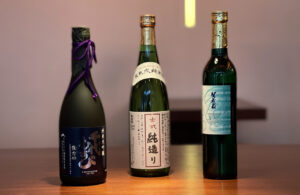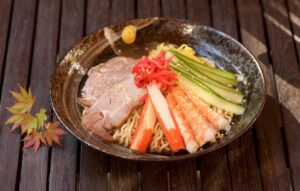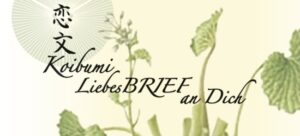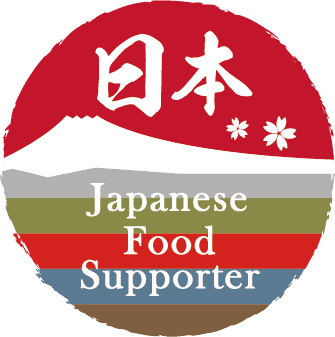Many small courses, whose ingredients and the respective preparation are just as coordinated with the season as the tableware used: that is Kaiseki. Kaiseki is considered the high form of classical Japanese cuisine.
One reads in various European as well as Japanese sources again and again that the culinary Kaiseki would have its origin in the Cha-Kaiseki, a small, light meal to the tea ceremony.
This is not correct, even though the two forms of kaiseki may go back to a common ancestor and both were shaped by the same contemporary historical influences.
In fact, there are some very interesting stories surrounding the history of kaiseki. Here we explain how culinary kaiseki evolved and where it resembles its "meditative" sibling cha-kaiseki and where it differs.
What are the culinary traditions that unite Kaiseki?
Modern Kaiseki reveals a whole range of traditional Japanese haute cuisine. But four influences in particular are very strong:
- die Küche des kaiserlichen Hofs, die sich ab dem 9. Jahrhundert (Heian-Zeit) herauskristallisiert hat, als Yūsoku-Ryōri (有職料理) bezeichnet
- the Buddhist cuisine of the temples Shōjin-Ryōri (精進料理) from about the 12th century (Kamakura period)
- the culinary customs of samurai households, Honzen-Ryōri (本膳料理), from the 14th century (Muromachi period)
- die besonderen Mahlzeiten, die die Teezeremonie begleiten, Cha-Kaiseki (茶懐石 oder auch nur 懐石), ab dem 15. Jahrhundert (ebenfalls Muromachi-Zeit).
Over time, these very different culinary traditions each developed their own formal language, became ritualized and remain so to this day. They all persist to this day, for themselves and in the Kaiseki kitchen.
How strongly each of the four different influences is valued is up to each chef. Thus, while one kaiseki refers more to its roots in imperial court cuisine, another kaiseki is dominated by borrowings from cha-kaiseki. Those who study kaiseki in depth also recognize the differences: court cuisine and samurai cuisine place a great deal of emphasis on adornment, understanding each individual course as an art form in its own right. Temple cuisine and the meals of the tea ceremony appear moderate, restrained, almost restricted in comparison.
Where does Kaiseki come from?
We can still trace kaiseki quite easily to Japan. Both kaiseki and cha-kaiseki are well known here and are still served today in various inns specializing in them.
But if we look for the historical developments, things quickly get complicated. How can we dissect and trace the various influences that kaiseki has experienced over the centuries? Chronologically, this is hardly possible, because kaiseki is always also an interpretation by the cook.
How a culinary tradition emerges from political upheaval
Both kaiseki and cha-kaiseki show clear borrowings from Honzen Ryōri, samurai cuisine. Honzen Ryōri was served to entertain guests in the households of the Buke (warrior caste, 武家) especially in the Muromachi period. An explanation is needed here:
In the West, we always speak of samurai when we refer to the Japanese warrior class. In Japan, however, these warriors are called bushi (武士). The first kanji (Sino-Japanese character) of Buke and Bushi is identical. Buke is the noble warrior caste (家, -ke, stands for the house, also in the sense of the family or household), while Bushi is the individual warrior.
This legendary warrior caste formed toward the end of the Heian period (794-1185) and developed through the Kamakura period (1185-1333). Thus, in the Muromachi period (1336-1573), we are already dealing with a highly developed social class that has a strong awareness of its status. This is due, among other things, to the political developments of the period. In the Muromachi period, the previously disempowered and purely representative imperial house attempted to disempower the strengthened warrior families and reestablish itself at the head of the Japanese empire.
Power and prestige shifts from the battlefield to the dining table
Of course, this did not suit the noble warrior families, who stood up to the upheaval in military conflicts. Warrior associations came together, community consciousness grew in this class.
Visits, entertainment, and meals became social kit and a matter of political survival.
The Buke meals served to guests exuded power and prestige. Usually, each of the many small dishes was elaborately arranged on plates, bowls and platters. The individual dishes were once again grouped together on a small table with low legs for sitting on tatami called zen (膳).
What does Kaiseki-Ryōri have to do with tea?
Even today, of course, you can drink tea with the kaiseki. But that is not the point here. We are still trying to trace the historical development of kaiseki. And now we're going to take it a step further: We're linking the history of kaiseki to the history of tea in Japan.
During the Nara and Heian periods, the Japanese imperial court sent envoys, called Kentōshi (遣唐使), to the Tang Dynasty in China and to the then Empire of Baekje (a part of today's Korea). There they studied customs and traditions, picked up ideas about crafts and science, and brought them back to Japan.
Along the way, Buddhism came to Japan, and at some point tea also entered the country. Buddhist monks first used tea as a medicine against exhaustion and fatigue. We still do today when we refer to the awakening properties of tein.
Drinking tea as a remedy for the exhaustion of the monks
Tea drinking slowly became more popular in Japan, but fell into oblivion again in the 10th and 12th centuries. It was not until the beginning of the 14th century that the Buddhist priest Musō Kokushi laid down rules on how tea should be prepared and enjoyed. These were the beginnings of the tea ceremony.
However, to this day, the Shōgun Ashikaga Yoshimasa is considered the real father of the tea ceremony. After resigning from all government offices, the man became a Buddhist abbot and refined the ritual of tea drinking more and more.
At some point, a light meal was served with the tea. One often reads that this developed into the Cha-Kaiseki.
When did tea become a social ritual?
Kaiseki (会席) or Kaiseki (懐石)?
In fact, both spellings are correct - to German ears both words sound the same, only by looking at the kanji characters used you can see that they are two different forms of kaiseki.
Culinary Kaiseki Character 会席
Kaiseki (会席) means what we call here the "culinary" kaiseki or kaiseki ryōri know This refers to a menu of selected dishes served individually for each guest on a separate tray. The first character, 会, stands for a gathering, a social event.
In the Edo period, when society was in upheaval and life suddenly developed at a much faster pace, gastronomy was not left unscathed. Numerous restaurants were invented, each aimed at a particular class of society and/or tied to a specific occasion. Life as a whole shifted more into the public sphere, and with it the taking of meals.
Kaiseki-Ryōri is one such occasion: sharing an elaborate meal as a social event can be traced back to the Edo period. Before that, these meetings probably took place more in private.
Character for the plain tea kaiseki 懐石
Kaiseki (懐石), on the other hand, means the plain meal served to guests of a cha-no-yu, even before tea. This is the spelling we also use for Cha-Kaiseki (茶懐石).
Common ancestors
The two different spellings are not entirely clear. Today it is assumed that Cha-Kaiseki and Kaiseki-ryōri developed from a common ancestor from the tea ceremony environment.
The legend with the stone against hunger
In our search for the origin and development of Cha-Kaiseki (懐石), we have repeatedly encountered a legend: Buddhist monks tried a lot to block out hunger. And they came up with the idea of putting a hot stone in the breast pocket of their robe to get rid of the feeling of hunger. The monks tried not to eat any food after noon. So hunger was a daily companion.
Of course, we don't know if there is any truth to this legend. But we do see the reference to the kaiseki in the kanji. The character 懐 actually refers to the so-called futokoro, the inside of the kimono. Here, the fabric forms a pocket through the girding and rests on the chest. To this day, valuables or other items are sometimes stowed in this pocket.
So if you come across the legend of the "chest stone" (kaiseki), now you know exactly what it's all about.
Dishes as Medicine - Yakuseki and the Relation to Cha-Kaiseki
The evening meal of the Buddhist monks is sometimes regarded as medicine and is supposed to bring health. Then one speaks of Yakuseki (薬石). The first kanji means "medicine", the second "stone". Here again we come to the legend with the stone: If the monks were sick, they were of course still allowed to have an evening meal. This was supposed to help them recover - the meal was thus proverbial medicine. The term yakuseki is still used today to refer to a light supper, especially an oatmeal.
Perhaps the current spelling of Cha-Kaiseki (茶懐石) developed from this later. The first kanji here means "tea", the second "robe", the third again "stone". The Japanese characters have been simplified, rearranged and changed over the centuries. Binding rules, which word is to be written how, do not exist for a long time yet. It is possible that kaiseki and cha-kaiseki come together here through language.
Another point speaks for a development of the Kaiseki and the Cha-Kaiseki from a common ancestor. Until the 16th century, both forms of the kaiseki were written with the same characters (会席) - so originally there was no spelling for the "stone-robed kaiseki" or cha-kaiseki.
It was not until the Edo period (1603-1868) that Japan began to build the theoretical framework known today around the tea ceremony. The Zen concept of "Kaiseki" was added later.
Kaiseki was therefore not originally anchored in Zen (and in the tea ceremony). But people knew very early in Japan: The strong tea Koi-cha (濃茶) is not good for the stomach as long as it is empty. Therefore, a light meal was served before drinking the tea. The meal as a preventive medicine before the high consumption of the tea - here we are again with the characters discussed above. Cha-Kaiseki is a very simple dish to this day.
Kaiseki and Cha-Kaiseki, a close relation?
Today, it is always emphasized that kaiseki and cha-kaiseki are closely related. Often, as evidence of the common origin in the culture of Zen Buddhism, it is cited that it is a vegetarian meal. However, this is not correct. For both kaiseki and cha-kaiseki know animal-based dishes. In the Kaiseki-ryōri, these are an integral part of the meal.
It stands to reason, then, that Kaiseki-ryōri and Cha-Kaiseki developed in parallel, perhaps from a common ancestor. Both are close in appearance and ideas to the Honzen-ryōri. But this did not have much to do with Buddhist abstinence.
Beware of false tradition: Kaiseki and also Cha-Kaiseki were not originally vegetarian!
Both forms of kaiseki as an expression of focus on the essentials
To better understand Kaiseki, perhaps we can start at another point: Kaiseki has not from a simple meal to haute cuisine. But throughout history, more and more useless elements and excess have disappeared from the kaiseki. Everything that was not needed for the idea of this elaborate meal was removed.
What remains today is what constitutes a pleasure for all the senses: the quintessence of the sensory experiences of regional and seasonal ingredients, harmoniously coordinated and prepared with the necessary respect for the treasures of nature.
So both kaiseki are ultimately a reduction to the absolute essentials, in one case the understated accompaniment to tea, in the other the artful completion and presentation of seasonal dishes.
More information about Kaiseki, tea and more
These are exclusively Japanese sources. But even for those who do not speak Japanese, a look at the websites is still worthwhile: The pictures speak for themselves!
- Tea in Japan
- Cha-Kaiseki
- The way of the tea (and associated dishes)
- Short History of Japanese cuisine
- Arrangement and consequence of the courts in various Japanese meals






